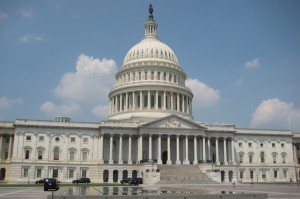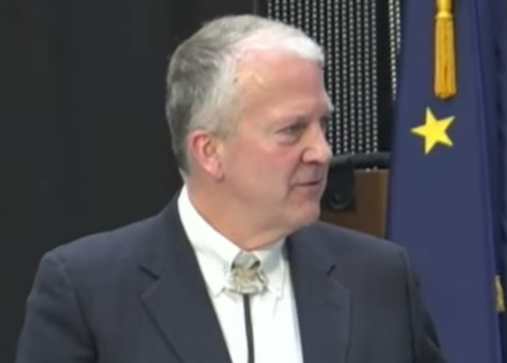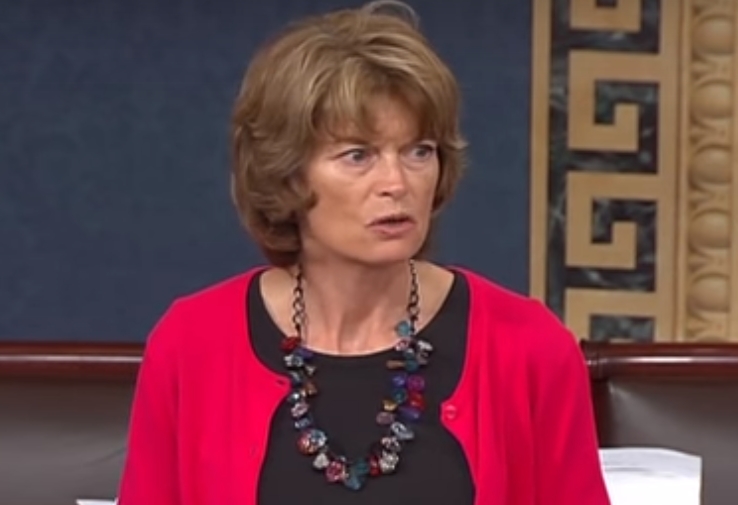 WASHINGTON, D.C. – The Senate passed the omnibus appropriations bill to fund the federal government through the remainder of Fiscal Year 2017, heading it to the President to be signed into law. As a member of the Appropriations Committee and Chairman of the Interior, Environment, and Related Agencies Subcommittee, U.S. Senator Lisa Murkowski (R-AK) was able to include provisions to address a wide range of challenges, needs, and opportunities for rural communities in Alaska.
WASHINGTON, D.C. – The Senate passed the omnibus appropriations bill to fund the federal government through the remainder of Fiscal Year 2017, heading it to the President to be signed into law. As a member of the Appropriations Committee and Chairman of the Interior, Environment, and Related Agencies Subcommittee, U.S. Senator Lisa Murkowski (R-AK) was able to include provisions to address a wide range of challenges, needs, and opportunities for rural communities in Alaska.
“This bill fulfills federal trust responsibilities that are important to the lives of Alaska Natives and sustains critical infrastructure investments in our rural communities,” said Senator Murkowski. “In addition to providing increased funding for basic water and much-needed sewer projects, the bill allows for a continuation of the subsistence lifestyle so important for our Native people. Simply put, the resources contained in this bill empower Alaska Natives and rural Alaskans to live in safe, and healthy communities.”
Click here for a comprehensive list and details of all Alaska-specific provisions in the omnibus.
Highlights of the Fiscal Year 2017 Omnibus Appropriations Bill include:
Denali Commission: Provides $15 million for the Commission tasked with coordination of construction and infrastructure efforts in rural Alaska.
Essential Air Service: Funds Essential Air Service at $150 million, a program to maintain commercial air service in approximately 60 small communities throughout Alaska.
Legacy Wells: Provides increased funding for the BLM to clean up exploration wells drilled at the direction of the federal government in NPR-A between 1944 and 1982. While Senator Murkowski secured significant funding to clean up these abandoned wells through the Helium Stewardship Act of 2013, nearly 30 will reportedly remain in need of remediation once that funding is exhausted. Murkowski’s bill nearly doubles the requested amount of funding for the clean-up of legacy wells, and also compels BLM to craft a long-term strategy to finally complete this effort.
Payment in Lieu of Taxes: Fully funds the Payment in Lieu of Taxes (PILT) program at $465 million, well above last year’s funding levels. The PILT program provides monetary compensation to local governments throughout Alaska that contain federal lands that are not subject to state or local taxation. The revenue helps local governments provide vital services, such as firefighting and police protection, construction of public schools and roads, and search-and-rescue operations.
Alaska Native Villages Water Program (EPA): Provides funds for the construction of new drinking water and wastewater systems, or the improvement of existing systems in rural Alaskan communities. Last year, funds awarded through this program went to ten different projects that will improve water and sanitation services for over 1,000 Alaskan homes.[xyz-ihs snippet=”adsense-body-ad”]Low Income Energy Assistance Program (LIHEAP): Allocates robust funds for the LIHEAP program – which acts as a crucial supplement for many Alaskans who face the highest energy prices in the nation. Over 11,000 Alaskan households received LIHEAP assistance in 2014.
Tribal Court Funding (PL280): Provides Tribal Courtfunding to Public Law 280 states, such as Alaska, in order to help develop tribal court systems for communities.
Tiwahe Initiative: Provides increased funding for this program to help communities design a comprehensive approach for the delivery of social services and justice programs.
Small and Needy Tribes: Provides direct support to ensure all tribes have a base level of support to run tribal governments.
Village Built Clinics (IHS): Directs funding for Village Built Clinics, a program unique to Alaska that supports healthcare clinics in villages and rural areas.
Contract Support Costs: Fully funds the contract support costs in the Bureau of Indian Affairs and the Indian Health Service to ensure tribes have the necessary resources they need to deliver programs and services. This is especially important to Alaska because all health care for Alaska Natives is directly provided by tribal organizations.
Small Ambulatory Clinics: Strongly encourages the Indian Health Service to fund the health clinics in Gambell and Savoonga. These health clinics provide critical services to Alaskans in two of the most remote areas of the state.
Alaska Subsistence (FS and FWS): Provides funds for the Forest Service and the Fish and Wildlife Service to conduct activities relating to the Federal Subsistence Board, and works with Alaska Natives to gather information, expand employment and capacity building, and assist subsistence users with law enforcement compliance activities, such as obtaining essential permits and meeting harvest reporting requirements.
Tribal Management: Provides additional funding for Alaska subsistence programs, extending critical pilot projects and ensuring additional opportunities for Alaska Native involvement in federal subsistence processes.
Polar Bear Populations: Requires the Fish and Wildlife Service to work with Alaska Native organizations and other wildlife management organizations with expertise in subsistence to implement a civil-based, co-management regime.
Arctic Council: Supports the Arctic Council and directs federal agencies to focus on economic opportunities in the region, as well as science and subsistence issues.
Zero Suicide Initiative: Increases funding for an IHS program aimed at preventing suicide by providing tools and support for organizations with patients receiving care. The initiative’s main belief is that suicide deaths for people receiving care are entirely preventable. In December 2015 the Alaska Native Tribal Health Consortium received training from the Zero Suicide program, providing tools and instructions for healthcare staff who treat and support suicidal patients.
Domestic Violence Prevention Initiative: Supports an IHS initiative that promotes culturally appropriate prevention and treatment approaches to domestic and sexual violence from a community-driven context. This includes funding projects that provide victim advocacy, intervention, case coordination, policy development, community response teams, sexual assault examiner programs, and community and school education programs. The Alaska Native Tribal Health Consortium, Aleutian Pribilof Islands Association, Bristol Bay Area Health Corporation, Chugachmiut, Copper River Native Association, Kodiak Area Native Association, Maniilaq Association, Norton Sound Health Corporation, Southcentral Foundation, and Southeast Alaska Regional Health Consortium all receive funds through this initiative to continue efforts in addressing domestic violence and sexual assault in their communities.
Alcohol and Substance Abuse: Provides an increase to IHS alcohol and substance abuse prevention programs to focus on tribal youth and the incorporation of more holistic healthcare models to improve outcomes. Programs within tribal communities to combat alcohol and substance abuse include inpatient and outpatient treatment, and rehabilitation services in both urban and rural settings.
Behavioral Health: Supports IHS programs to address issues such as substance use disorders, mental health disorders, suicide, violence, and behavior-related chronic diseases among American Indians and Alaska Natives. Similar to the NUKA model at Southcentral Foundation, the program is a comprehensive system of care, which encourages community support and strong collaborative relationships with other agencies.
Community Health Centers: Language in this bill also directs increased funding to facilitate expansion into providing behavioral health and substance abuse treatment – addressing two critical issues prevalent in Alaska.
Violence Against Women Act (VAWA) Grant Programs: The Department of Justice’s Office on Violence Against Women (OVW) administers multiple grant programs designed to reduce domestic violence and sexual assault by strengthening services to victims and holding offenders accountable. The VAWA grant programs are funded at $481.5 million.
ANCSA Contaminated Lands: Directs BLM to coordinate with all responsible federal agencies to clean lands up as soon as possible and find a long-term cleanup solution.
State Water Revolving Funds: Provides funding to help local communities improve water infrastructure in both the wastewater and drinking water areas. Funding from this program can be used to address problems like lead content in water.
Transboundary Water Quality: Provides funding for transboundary river streamgages and directs the BIA and USGS to enter into a formal partnership with local tribes to develop a water quality strategy for transboundary rivers.
The Fiscal Year 2017 Omnibus Appropriation Bill also includes funding for additional programs supporting health, education and essential services for Alaskans including:
Wildfire Prevention and Suppression: The bill funds our nation’s wildfire suppression efforts at the historic 10-year average and includes additional emergency funds that will be available in the event of a catastrophic fire season. Also included is increased funding for preventative measures that can be taken in advance of wildfire season, such as hazardous fuels reduction and mitigation.
3D Alaska Mapping: Includes additional funding for the Alaska mapping initiative that will help gather data to improve maps, enhancing safety for activities such as aviation. Just last August, Alaska surpassed the halfway mark in updating the state’s digital mapping and data collection. Currently much of the terrain data in Alaska is more than 50 years old and hand-sketched from photos shot from World War II reconnaissance craft.
USGS Earthquake and Volcano Hazards: Provides funding for earthquake and volcano monitoring, with direction to upgrade the technical infrastructure in Alaska.
Mineral Resources Program and Geophysical Studies: Funding is restored for Alaska geological mapping. Also, directs USGS to conduct studies that would significantly expand the public’s knowledge of the minerals resource potential in Alaska, and to begin studies on oil and gas resources in low permeability reservoirs.
Kagalaska and Chirikof: Prohibits the Fish and Wildlife Service (FWS) from using funds to conduct a costly caribou hunt on Kagalaska Island in the Aleutian Chain. The FWS has previously estimated that it would cost $71,000 in taxpayer money to send four employees to the island to hunt and process the caribou. The legislation also prohibits costly and impractical efforts to remove cattle from the remote Chirikof Island.
GE Salmon: After the FDA’s decision in 2015 to approve genetically engineered (GE) salmon for human consumption, Senator Murkowski promised to fight back for the health of both consumers and Alaska’s fisheries. Murkowski successfully included a provision in the omnibus that bans that blocks the Food and Drug Administration (FDA) from introducing GE salmon into the market until it publishes labeling guidelines so consumers are aware of what is contained in the product they are purchasing.
Golden King Crab Nomenclature: Senator Murkowski secured language to amend the Federal Food, Drug, and Cosmetic Act to update the FDA’s seafood list to change the acceptable market name of Brown King Crab to “Golden King Crab.”
Alaska Native/Native Hawaiian Serving Institutions: Funded at $3.2 million to help these institutions improve and expand their ability to prepare graduates for the food and agricultural sciences and to research effects of climate change invasive species and pests in agricultural settings.
Tribally Controlled Colleges and Universities (1994 Institutions): Funded at $4.4 million to help institutions prepare students to contribute to and strengthen their communities
Food and Nutritional Services:
- Supplemental Nutrition Assistance Program (SNAP): $78.5 billion
- Food Distribution Program on Indian Reservations: $151 million
- Supplemental Nutrition Program for Women, Infant, and Children (WIC): $6.35 billion
- The Emergency Food Assistance Program (TEFAP) Storage and Distribution: $59.4 million
- Commodity Supplemental Food Program (CSFP): $236.1 million to help low income elderly individuals by supplementing their diets with nutritious USDA foods.
- Section 32 Funds: A transfer of $20.7 million to purchase commodities from producers affected by adverse market conditions and donate them to schools, food banks, and food pantries.
- Child Nutrition Programs:
- National School Lunch Program: $12.4 billion
- School Breakfast Program: $4.5 billion
- Child and Adult Care Food Program: $3.5 billion
- Summer Food Service Program: $627 million
- Farm to School Program: $4.2 million
- School Nutrition Equipment Grant: $25 million
Legal Services Corporation: Provides $45 million to strengthen civil and criminal legal assistance programs for low-income Americans.
Victims of Child Abuse Act: $21 million has been allocated to support victims of child abuse and help them cope psychologically. This is an increase of $1 million from last year.
Arctic Deep Draft Port Study: Secured report language encouraging the Army Corps of Engineers to continue to thoroughly evaluate the proposed deep draft port in Nome, taking into account the wide range of economic benefits the project would bring to the region, the expansion of search and rescue capabilities it would provide, and the national security reasons for its construction.
Native Programs: Recommends funds for grants, loans, and technical assistance and training programs to benefit Native American, Alaskan Natives, and Native Hawaiian communities in the coordination of development strategies, increased access to equity investments, and loans for developmental activity.
Impact Aid: Increases funds for Impact Aid – which reimburses school districts for the cost of educating students who live on properties that are tax-exempt due to federal law. This includes students who live on, or parents who work on, military installations, federally-designated low-income housing, and Native lands.
Title VI Indian Education Formula Grants: Allocates funds to address the unique education and culturally related academic needs of American Indian and Alaska Native students.
21st Century Community Learning Centers: Directs resources to support afterschool programs to give working parents peace of mind and keep kids safe and engaged in learning after school.
Alaska Native Education Equity Program (ANEP): Supports ANEP, a program designed to meet the unique education needs of Alaska Native students.
Strengthening Alaska Native and Native Hawaiian Serving Institutions: Promotes and strengthens the ability of Alaska Native-Serving Institutions and Native Hawaiian-Serving Institutions to carry out education, applied research, and related community development programs. This is an important program for several of Alaska’s rural UA campuses.
Strengthening Tribally Controlled Colleges and Universities: Strengthens support for educational institutions operated by American Indian tribes – including Iḷisaġvik College in Barrow, Alaska.
Privacy of Student Data: Directs the Department of Education to adhere to the strictest and highest standards for protecting personally identifiable information (PII) and requires the Department to report to Congress on their actions taken to comply with this directive.
Indian Education National Activities: Ensures funds will be available to support Native American and Alaska Native Language Immersion Schools and Programs, a new program crafted by Senator Murkowski in the Every Student Succeeds Act. It has been determined that schools where indigenous language is the primary language of instruction have a strong, positive effect on Alaska Native students.
Domestic Violence: Provides funds to the Alaska State Resource Center on Domestic Violence.
Title V Maternal and Child Health Services Block Grant: Increases funds for the Title V Maternal and Child Health Services Block Grant, to improve the health of mothers and children, including children and youth with special health care needs.
Title X Family Planning/Teen Pregnancy Prevention: Directs funds to ensure access to a broad range of family planning and preventive health services.
State Public Health Actions on Chronic Diseases: Directs resources to boost programs aimed at preventing chronic diseases – including obesity, diabetes, heart diseases, and strokes.
Preventative Health and Health Services Block Grant: Funds the Preventative Health and Health Services Block Grant, which is used in Alaska to address basic health concerns related to chronic disease, rape prevention, and unintentional injuries.
Suicide Prevention: Allocates resources for suicide prevention efforts including the Suicide Lifeline, Garrett Lee Smith Youth Suicide prevention funds, and the American Indian and Alaska Native Suicide Prevention Initiative.
Opioids and Substance Abuse Prevention: Provides robust funding to combat the opioid abuse epidemic in Alaska and throughout the nation.
Tribal Transportation Program: Funded at $465 million.
Transportation Investment Generating Economic Development (TIGER) Grants: Provides $500 million for capital projects that generate economic development and improve access to reliable, safe, and affordable transportation for communities.
Home Investment Partnerships (HOME) Program: Allocates $950 million to fund the HOME Investment Partnerships program—a critical program to support affordable housing needs.
Native American Housing Block Grants: Provides $654 million for the Native American Housing Block Grant, to provide a range of affordable housing activities on Indian reservations and Indian areas.
Indian Housing Loan Guarantee Fund: Provides $7.2 million for the Indian Housing Loan Guarantee Fund, a home mortgage specifically designed for American Indian and Alaska Native families, Alaska Villages, Tribes, or Tribally Designated Housing Entities.
HUD-VASH Demonstration Program for Homeless and At-Risk Native Vets: Allocates $7 million for a demonstration program to offer a permanent home and supportive services to Native American Veterans who are experiencing or at risk of experiencing homelessness.[xyz-ihs snippet=”Adsense-responsive”]







